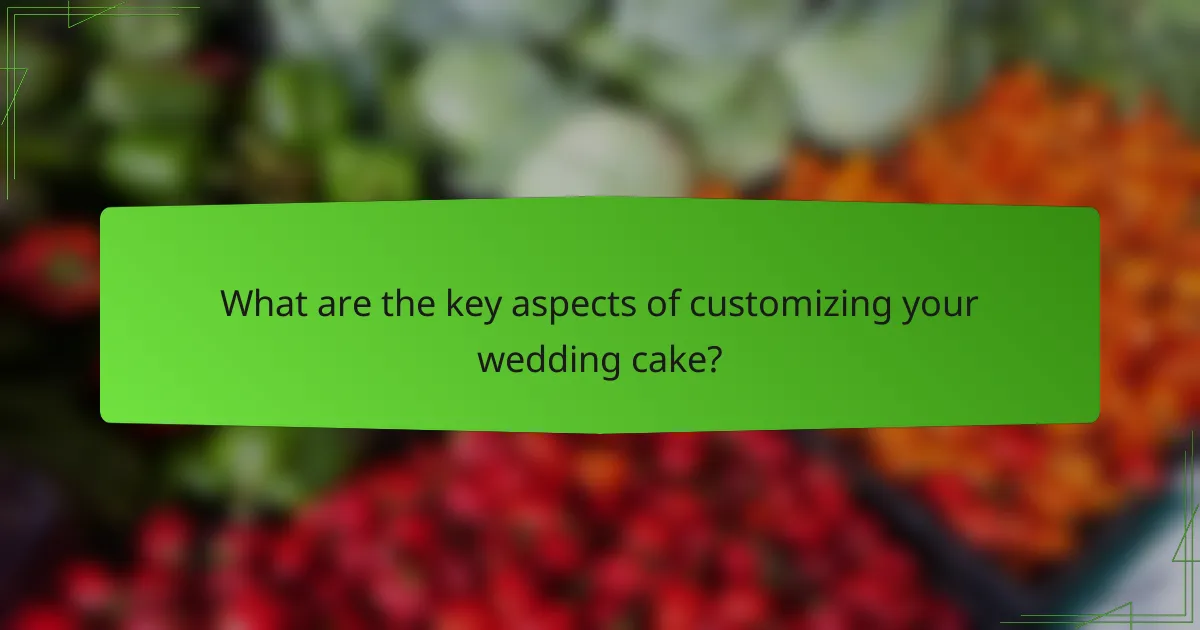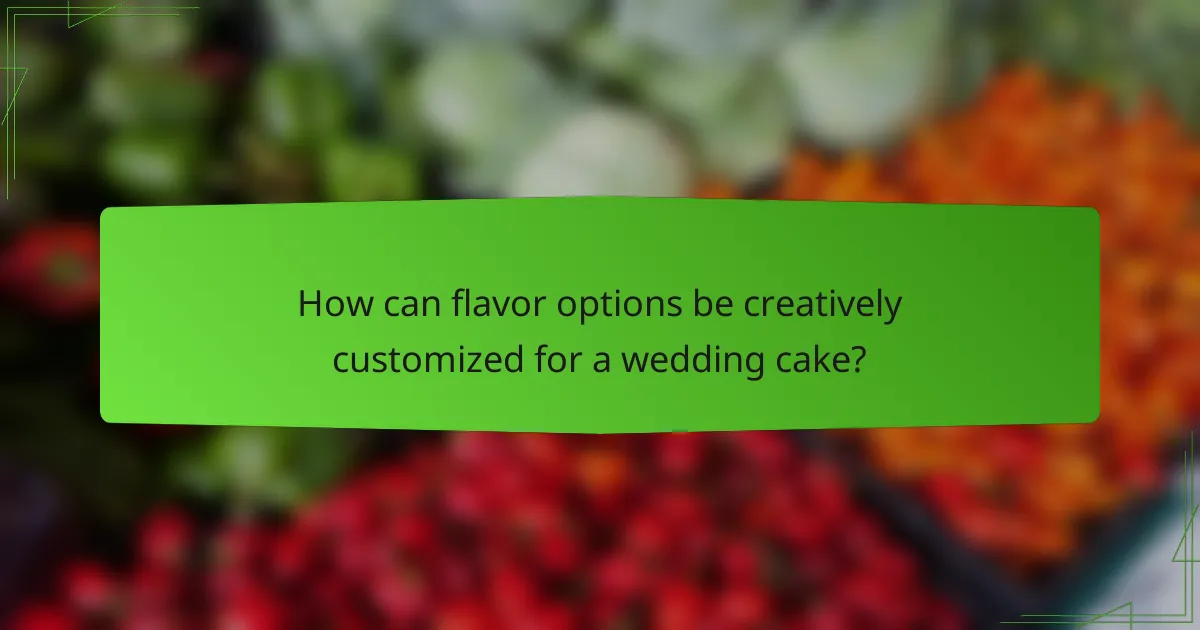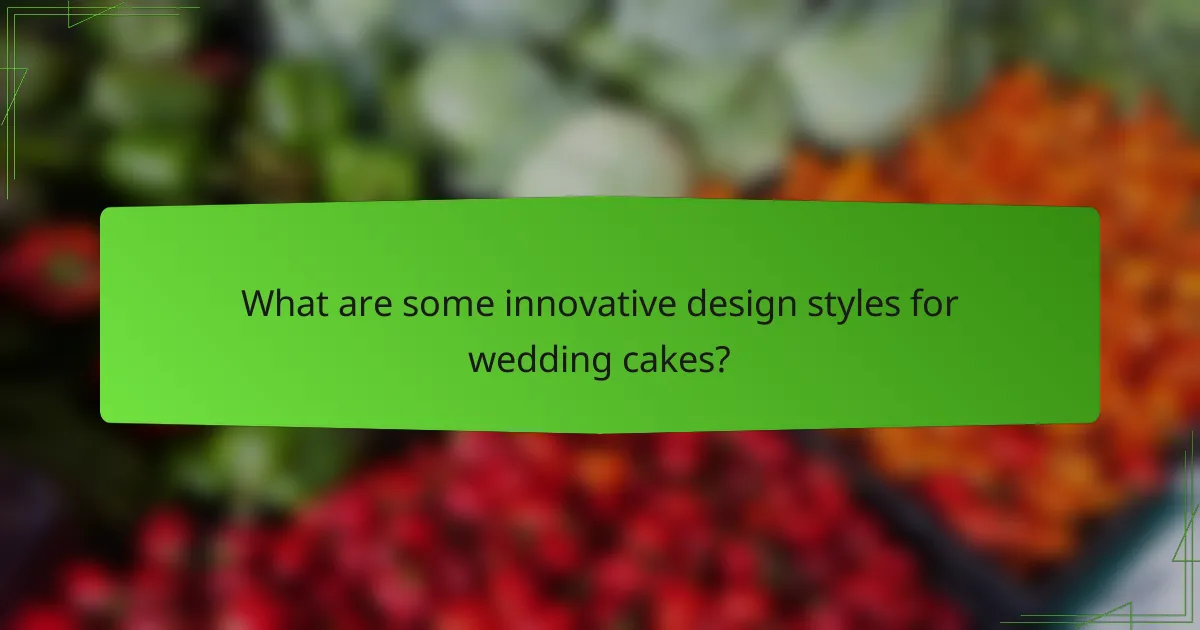
What are the key aspects of customizing your wedding cake?
The key aspects of customizing your wedding cake include flavor selection, design style, and size considerations. Flavor selection allows couples to choose their favorite cake types, such as vanilla, chocolate, or red velvet. Design style encompasses elements like color schemes, tier arrangements, and decorative details. Size considerations involve determining the number of guests to ensure adequate servings. Customization also includes dietary preferences, such as gluten-free or vegan options. Each aspect contributes to the overall personalization of the cake, making it unique to the couple’s vision.
How do flavor options influence the customization of a wedding cake?
Flavor options significantly influence the customization of a wedding cake by allowing couples to reflect their personal tastes. Different flavors can cater to diverse guest preferences, enhancing overall satisfaction. Popular choices include classic vanilla, rich chocolate, and unique options like red velvet or lemon. The selection of flavors can also dictate the cake’s design, as certain flavors pair better with specific frostings or fillings. For instance, a citrus-flavored cake often complements a light buttercream. Additionally, flavor combinations can create a more memorable experience, such as pairing chocolate with raspberry. Ultimately, the chosen flavors contribute to the cake’s visual appeal and thematic coherence, reinforcing the wedding’s overall aesthetic.
What are the most popular flavor options for wedding cakes?
The most popular flavor options for wedding cakes include vanilla, chocolate, and red velvet. Vanilla is favored for its classic taste and versatility. Chocolate offers a rich flavor that many couples enjoy. Red velvet is known for its unique color and subtle cocoa flavor. Other popular choices are lemon, almond, and carrot cake. Lemon provides a refreshing citrus flavor. Almond adds a nutty twist to traditional cakes. Carrot cake is appreciated for its moist texture and spices. According to wedding industry surveys, these flavors consistently rank high among couples’ preferences.
How can couples choose flavors that reflect their personalities?
Couples can choose flavors that reflect their personalities by considering their individual tastes and preferences. They should discuss their favorite flavors, such as chocolate, vanilla, or fruit. Each flavor can symbolize different traits; for example, chocolate may represent richness and indulgence, while citrus flavors can reflect freshness and zest for life. Couples can also think about shared experiences tied to specific flavors, like a favorite dessert from their first date. Additionally, they can explore unique flavor combinations that represent their relationship, such as pairing sweet and spicy flavors. Ultimately, selecting flavors that resonate with their story enhances the cake’s personal significance.
What design styles can be incorporated into a wedding cake?
Wedding cakes can incorporate various design styles. Popular styles include classic, modern, vintage, and rustic. Classic wedding cakes often feature elegant tiers with smooth fondant and intricate piping. Modern designs may include geometric shapes and bold colors. Vintage cakes often showcase lace patterns and pastel colors, reflecting a nostalgic aesthetic. Rustic styles typically use natural elements like wood and flowers for a more organic look. Each style can be customized to match the couple’s theme and preferences.
What are the trending design styles for wedding cakes?
Trending design styles for wedding cakes include minimalist, floral, and geometric designs. Minimalist cakes often feature clean lines and simple decorations. Floral designs incorporate fresh or edible flowers for a romantic touch. Geometric cakes use bold shapes and patterns for a modern look. Other popular styles are watercolor effects and metallic accents. These trends reflect current aesthetics in wedding celebrations. According to wedding industry reports, couples increasingly prefer personalized and unique cake designs.
How can personal themes and colors be integrated into the cake design?
Personal themes and colors can be integrated into cake design through various methods. Selecting a color palette that reflects the couple’s personality is essential. This can include their favorite colors or shades that match the wedding theme. Custom decorations, such as fondant figures or edible images, can represent personal interests or hobbies. Incorporating unique elements like monograms or initials adds a personal touch. Flavor choices can also align with personal significance, such as a favorite dessert. Using themed cake toppers can enhance the overall design. These methods ensure that the cake is a true reflection of the couple’s identity and style.
What size considerations should be made when customizing a wedding cake?
When customizing a wedding cake, size considerations are crucial for serving guests adequately. The cake size should reflect the number of guests attending the wedding. A general guideline is to allocate one slice per guest. Common wedding cake sizes include tiers of 6, 8, 10, and 12 inches. Each tier can serve approximately 10 to 30 guests, depending on its height and shape.
The height of the cake also impacts the overall size. Taller cakes may require additional support structures. Additionally, the design and number of tiers can affect the visual impact and serving size. A multi-tiered cake may create a grand appearance but requires careful calculation for guest servings.
Lastly, consider the venue space. The cake should fit comfortably on the designated table without overwhelming the decor. These size considerations ensure both aesthetics and practicality for the wedding celebration.
How do guest count and portion size affect cake sizing?
Guest count and portion size directly influence cake sizing. A higher guest count requires a larger cake to ensure everyone receives a slice. Standard cake serving sizes typically range from 1 to 2 inches per slice. For example, a cake serving size of 1 inch can yield more slices than a 2-inch serving.
If a wedding has 100 guests and a standard serving size of 1 inch, a cake around 6 to 8 inches tall and 12 to 14 inches in diameter is generally appropriate. Conversely, if the portion size is increased to 2 inches, a larger cake, approximately 10 to 12 inches in diameter, may be necessary to accommodate the same number of guests.
Therefore, both guest count and desired portion size are critical factors in determining the appropriate cake size for an event.
What are the different tier options available for wedding cakes?
Wedding cakes typically offer various tier options. Common configurations include single-tier, two-tier, three-tier, and multi-tier designs. A single-tier cake serves smaller gatherings. Two-tier cakes are popular for medium-sized weddings. Three-tier cakes are often chosen for larger celebrations. Multi-tier cakes can have four or more layers. Each tier can be different in flavor or design. The choice of tiers impacts the cake’s overall height and visual appeal.

How can flavor options be creatively customized for a wedding cake?
Flavor options for a wedding cake can be creatively customized through various methods. Couples can blend traditional flavors like vanilla or chocolate with unique options such as lavender or chai. Incorporating seasonal ingredients adds freshness and relevance to the cake. For example, using fresh berries in summer or spiced flavors in fall enhances the overall theme.
Layering different flavors in each tier allows for a diverse tasting experience. Couples may also consider incorporating their cultural backgrounds by adding flavors that represent their heritage. Custom fillings, such as fruit preserves or flavored creams, can further enhance the cake’s taste profile.
Additionally, offering a flavor tasting session ensures the couple chooses the best combinations. These creative choices not only personalize the cake but also make it memorable for guests.
What unique flavor combinations can be considered?
Unique flavor combinations for wedding cakes include lavender and honey, which creates a floral and sweet profile. Another option is lemon and blueberry, offering a refreshing and tangy taste. Chocolate and raspberry provide a rich and fruity contrast. Additionally, vanilla and almond deliver a classic yet distinctive flavor blend. Spice flavors like chai and pumpkin can evoke warmth and comfort. Coconut and lime create a tropical flair, while caramel and sea salt add a sophisticated twist. These combinations enhance the overall cake experience, appealing to diverse palates.
How can seasonal ingredients enhance flavor choices?
Seasonal ingredients enhance flavor choices by providing fresh, vibrant tastes that reflect the time of year. Using ingredients like ripe strawberries in summer or spiced apples in fall can create unique flavor profiles. These ingredients often have peak flavor and nutritional value during their respective seasons. For instance, strawberries are at their sweetest in June, making them ideal for summer wedding cakes. Seasonal ingredients also support local agriculture, promoting sustainability. They can inspire creative combinations, such as pairing pumpkin with warm spices in autumn cakes. Overall, incorporating seasonal ingredients leads to more flavorful and memorable culinary experiences.
What role do dietary restrictions play in flavor selection?
Dietary restrictions significantly influence flavor selection for wedding cakes. These restrictions include allergies, intolerances, and lifestyle choices such as veganism or gluten-free diets. For instance, a gluten allergy would necessitate the use of gluten-free ingredients. Vegan preferences would require plant-based alternatives for eggs and dairy.
Flavor options must be adapted to accommodate these dietary needs. This can limit traditional flavor profiles but also encourages creativity in flavor combinations. For example, using almond milk can create a unique flavor in vegan cakes.
Awareness of dietary restrictions ensures that all guests can enjoy the cake without health concerns. This approach fosters inclusivity and enhances the overall experience of the celebration.

What are some innovative design styles for wedding cakes?
Innovative design styles for wedding cakes include [censured] cakes, geometric designs, and watercolor effects. [censured] cakes feature exposed layers and minimal frosting, emphasizing natural ingredients. Geometric designs incorporate sharp lines and shapes, creating a modern aesthetic. Watercolor effects use blended colors to mimic artistic paintings on cake surfaces. These styles reflect contemporary trends in cake design. They cater to diverse tastes and themes, allowing personalization. Each style enhances the visual appeal of wedding celebrations.
How can couples personalize their cake designs?
Couples can personalize their cake designs by incorporating unique elements that reflect their personalities and relationship. They can choose specific colors that match their wedding theme. Custom flavors can also be selected to cater to their tastes. Couples may add personal toppers, such as figurines or monograms. Edible images or messages can be printed on the cake to convey special sentiments. Additionally, they can select distinct shapes or tiers that symbolize their journey together. Using seasonal flowers or favorite decorations can enhance the cake’s visual appeal. These personalized touches make the cake a memorable centerpiece for the celebration.
What are the benefits of incorporating cultural elements into cake design?
Incorporating cultural elements into cake design enhances personalization and significance. It allows couples to reflect their heritage and traditions. This practice can create a deeper emotional connection to the cake. Cultural designs can also introduce unique flavors and styles. For instance, incorporating traditional motifs can make the cake visually striking. Additionally, it can engage guests by showcasing diverse cultural backgrounds. Research shows that personalized wedding cakes contribute to memorable experiences for couples and their guests. Overall, cultural elements enrich the overall wedding celebration.
How can edible decorations enhance the visual appeal of the cake?
Edible decorations enhance the visual appeal of a cake by adding color, texture, and creativity. These decorations can include items like edible flowers, fondant shapes, or colored sprinkles. They create focal points that draw the eye and elevate the overall design. The use of vibrant colors can make the cake more inviting and festive. Textural contrasts, such as smooth fondant against rough sprinkles, add depth to the appearance. Creative designs can reflect the theme of an event, making the cake more personal. For instance, a floral design can complement a garden wedding. Research indicates that visually appealing food can increase enjoyment and satisfaction. This is supported by studies showing that presentation affects taste perception.
What practical tips should couples consider when customizing their wedding cake?
Couples should consider several practical tips when customizing their wedding cake. First, they should select flavors that reflect their personal tastes. Popular choices include vanilla, chocolate, and red velvet. Next, couples should think about the cake’s design. They can incorporate elements from their wedding theme, such as colors and decorations. Additionally, couples should determine the size of the cake based on the number of guests. A common guideline is to plan for one slice per guest. Couples should also discuss dietary restrictions with their baker. This ensures that options are available for all guests. Finally, couples should schedule a tasting session with their baker. This allows them to sample different flavors and finalize their choices.
How can couples effectively communicate their vision to the baker?
Couples can effectively communicate their vision to the baker by being clear and detailed about their preferences. They should start by discussing the overall theme of the wedding. Sharing inspiration images can help convey their design ideas. Couples should specify flavor preferences and any dietary restrictions. Providing a budget range is also essential for the baker’s planning. Open communication about timelines ensures that the cake is ready on time. Couples should ask for the baker’s input and expertise, as they have valuable experience. Documenting all agreements in writing can prevent misunderstandings.
What are the common pitfalls to avoid in wedding cake customization?
Common pitfalls to avoid in wedding cake customization include not communicating clearly with the baker. Clear communication ensures that your vision is understood. Another pitfall is neglecting to consider the number of guests. The cake size must accommodate all attendees. Additionally, overlooking flavor preferences can lead to disappointment. It’s essential to choose flavors that appeal to your guests. Aesthetic choices should also align with the wedding theme. Mismatched designs can detract from overall decor. Lastly, failing to plan ahead can result in rushed decisions. Early planning allows for better customization options.
The main entity of the article is the wedding cake, with a focus on its customization aspects including flavor options, design styles, and size considerations. Key information includes the significance of flavor selection in reflecting personal tastes, popular flavors like vanilla and chocolate, and how design styles such as minimalist and floral can enhance the cake’s aesthetic. Additionally, the article addresses practical size considerations based on guest count and portion sizes, as well as the importance of incorporating dietary preferences. Overall, the content provides a comprehensive guide for couples looking to personalize their wedding cake to align with their vision and celebration.
